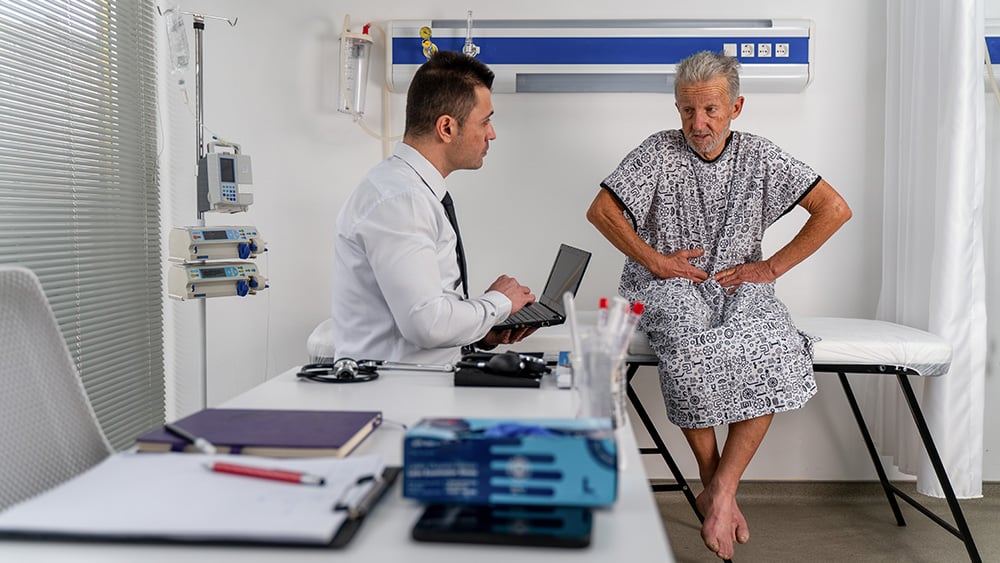Key Takeaways
- Hernias are caused by tissue or an organ bulging through a defect in the abdominal wall.
- The type, location, and tissue causing the hernia all factor into how it will be treated by a healthcare provider.
- If a hernia does require surgery, most hernia repair procedures are simple and can be done at an outpatient facility.
Hernias are a common health problem – caused by tissue or organs bulging through a defect in the abdominal wall. More than 20 million hernia repairs are performed each year worldwide.
Hernias can range from a very small and simple defect to a very large and complex one. A hernia is usually something that is easily noticed as a visible or palpable bulge.
As a surgeon at several Rochester Regional Health hospitals, Lewis Zulick, MD, MMM, FACS, treats hernias regularly. He explains the different types of hernias, how they are diagnosed, and how surgical teams treat patients with hernias to provide relief.
Common types of hernias
Groin (inguinal) hernia
The most common type of hernia, this occurs most often in men because of a natural defect in the abdominal wall created by the descent of the testicle into the scrotum during a male baby’s development. However, it can also develop in women – which can sometimes be a more dangerous condition.
Belly button hernia
This hernia develops at the area where the umbilical cord creates a natural defect as it passes through a baby’s abdominal wall during pregnancy.
“Normally, both of these types of natural defects in the abdominal wall close over after birth but, in some people, they remain slightly open and allow the development of a hernia,” Dr. Zulick said.
Hiatal hernia
This hernia is a protrusion of the stomach through the diaphragm, which is a sheetlike muscle that separates the chest from the abdomen. This type of hernia is internal and is not visible like an abdominal wall hernia. These will rarely cause problems and do not commonly require repair.
How to diagnose a hernia
Symptoms of hernias can vary because the type, location, and kind of tissue associated with a hernia differs from person to person.
Some common symptoms of hernias include:
- a bulge or lump that can be seen and/or felt
- pain
- pressure or pinching during certain movements
If you are feeling any of these symptoms, schedule a visit with your primary care provider. They will perform a physical exam and, if necessary, obtain an ultrasound to confirm there is a hernia present. Depending on whether the hernia is causing symptoms and also on the type, size and location of the hernia they may recommend monitoring the hernia or to obtain consultation with a surgeon to consider repair.
Unfortunately, hernias do not heal on their own, so avoiding or delaying treatment only makes sense if the hernia is causing minimal or no symptoms and has a low risk of developing future problems.
“For someone with a hernia that is causing no pain, they may just watch and wait,” Dr. Zulick said. “This is especially true of very small hernias around the belly button which have a very low risk for subsequent problems. The only danger of a hernia is the potential for incarceration or strangulation. This occurs when the hernia becomes ‘stuck’ and does not move freely in and out. For most hernias this risk is small.”
How to treat a hernia
Most people elect to have their hernia repaired either because of the pain it is causing or because of other health concerns.
Hernia repairs can be quite simple or very complex depending on:
- the type of hernia
- the location of the hernia
- the type of protruding tissue
Inguinal or groin hernias and umbilical hernias usually are quite simple to repair and the surgery can be done at an outpatient facility.
Hernias that develop after other abdominal operations, called incisional hernias, tend to be more complex and often require a hospital stay. Most people can return to relatively normal activity within four weeks after a groin or umbilical hernia repair. Larger or more complex hernias usually require a longer recovery period.
Most hernias are repaired with implantation of mesh material to patch the abdominal wall defect. The use of mesh has been shown to significantly reduce the risk of hernia recurrence for almost all types of hernia repair. Although the use of mesh has risks, studies have clearly shown that its advantages outweigh those risks. Patients with concerns about the use of mesh should discuss those concerns with their surgeon.
Surgeons at Rochester Regional Health are skilled at all types of hernia repair techniques, including minimally invasive techniques using laparoscopic or robotic surgery. Minimally invasive repairs often can result in less postoperative pain and quicker return to normal activity. Hernia repair can be done through one open incision or with the use of laparoscopic or robotic instruments through multiple small incisions. There are pros and cons to each approach depending on the type of hernia – all of which should be discussed with the patient’s surgeon before deciding on which type of hernia repair is right for them.
“We treat hernias often and are able to get many of our patients back to regular life again within a reasonable amount of time,” Dr. Zulick said. “If you are struggling with pain that might be from a hernia, get in touch with your primary care provider and see if surgery might be right for you.”










